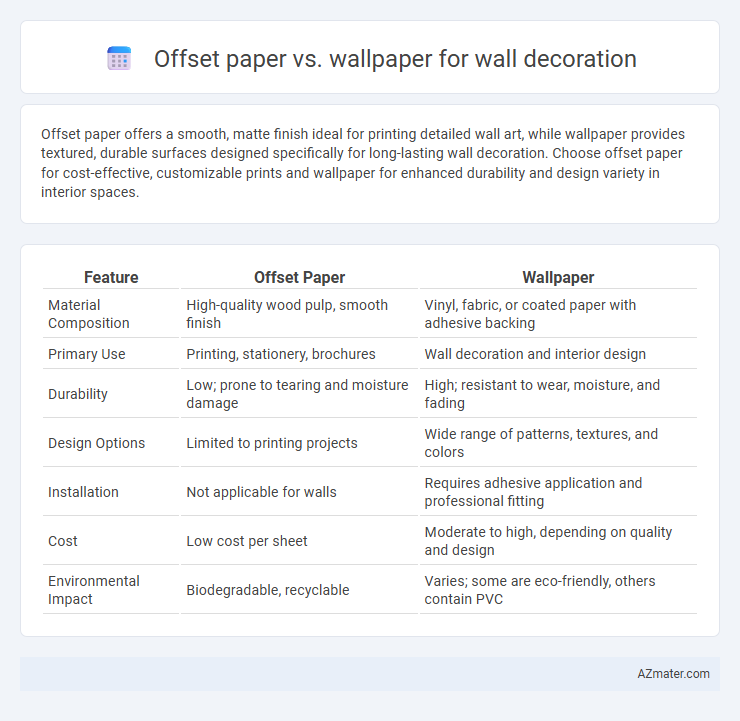Offset paper offers a smooth, matte finish ideal for printing detailed wall art, while wallpaper provides textured, durable surfaces designed specifically for long-lasting wall decoration. Choose offset paper for cost-effective, customizable prints and wallpaper for enhanced durability and design variety in interior spaces.
Table of Comparison
| Feature | Offset Paper | Wallpaper |
|---|---|---|
| Material Composition | High-quality wood pulp, smooth finish | Vinyl, fabric, or coated paper with adhesive backing |
| Primary Use | Printing, stationery, brochures | Wall decoration and interior design |
| Durability | Low; prone to tearing and moisture damage | High; resistant to wear, moisture, and fading |
| Design Options | Limited to printing projects | Wide range of patterns, textures, and colors |
| Installation | Not applicable for walls | Requires adhesive application and professional fitting |
| Cost | Low cost per sheet | Moderate to high, depending on quality and design |
| Environmental Impact | Biodegradable, recyclable | Varies; some are eco-friendly, others contain PVC |
Introduction: Offset Paper vs Wallpaper
Offset paper offers a smooth, matte finish ideal for printing high-quality wall art with sharp details and vibrant colors, making it a popular choice for custom wall decorations. Wallpaper provides textured surfaces and patterns that add depth and character to interiors while being durable and easy to clean, suitable for long-term wall coverage. Choosing between offset paper and wallpaper depends on the desired aesthetic effect, installation method, and durability requirements for the space.
Understanding Offset Paper: Composition and Features
Offset paper, commonly used in printing, consists of high-quality wood pulp with minimal lignin, resulting in a smooth surface ideal for detailed images and text. Its composition ensures excellent ink absorption and resistance to smudging, making it suitable for high-precision prints but less durable for direct wall applications compared to wallpaper. Wallpaper, typically crafted from vinyl, fabric, or coated paper, offers enhanced durability, moisture resistance, and texture options specifically designed for long-term wall decoration.
What is Wallpaper? Types and Characteristics
Wallpaper is a decorative material used to cover and enhance interior walls, available in various types such as vinyl, non-woven, paper-based, and fabric-backed. Each type offers distinct characteristics: vinyl wallpaper is durable and washable, non-woven is breathable and easy to install, paper-based is eco-friendly but less moisture-resistant, and fabric-backed adds texture and elegance. Wallpaper provides design versatility with patterns, textures, and colors, making it a popular choice for adding style and personality to spaces.
Aesthetic Appeal: Visual Impact Comparison
Offset paper offers a smooth, matte finish with precise color reproduction, enhancing minimalist and modern wall designs through subtle texture and refined detail. Wallpaper provides a wide range of patterns, textures, and finishes, creating bold visual statements and allowing for intricate designs that can dramatically transform a space. Wallpapers often deliver a higher visual impact with their versatility in styles, ranging from classic damasks to contemporary geometric patterns, making them ideal for dynamic and personalized wall decoration.
Durability and Longevity: Which Lasts Longer?
Offset paper offers moderate durability but tends to fade and wear over time due to its porous surface, making it less suitable for high-traffic areas. Wallpaper, especially vinyl-coated varieties, provides superior longevity and resistance to moisture, scratches, and fading, ensuring a longer-lasting decorative finish. Choosing wallpaper is generally more reliable for maintaining vibrant wall aesthetics over extended periods.
Installation Process: Ease and Practicality
Offset paper offers straightforward installation with user-friendly adhesives and easy trimming, making it ideal for DIY enthusiasts. Wallpaper, while providing a broader variety of textures and designs, often requires professional tools and experience to handle paste application and alignment. Practicality favors offset paper for quick, clean setups, whereas wallpaper excels in aesthetic variety but demands more skill and time.
Cost Analysis: Offset Paper vs Wallpaper
Offset paper offers a more budget-friendly option for wall decoration, with typical costs ranging between $0.50 to $2 per square foot, making it ideal for large projects or temporary uses. Wallpaper, while generally more expensive--averaging $2 to $7 per square foot including installation--provides greater durability and a wide variety of patterns and textures, which can justify the higher investment in long-term applications. Considering installation and maintenance expenses is crucial, as offset paper often requires less professional labor but may need replacement sooner, whereas wallpaper's upfront cost is offset by its longevity and resistance to wear.
Maintenance and Cleaning Requirements
Offset paper offers a smooth, durable surface that resists scratches and stains, making it relatively easy to clean with a damp cloth and mild detergent. Wallpaper, especially vinyl-coated varieties, provides superior moisture resistance and can be wiped down without damage, but delicate patterns or materials may require careful handling to avoid tears. Regular dusting and spot cleaning extend the lifespan and maintain the aesthetic appeal of both offset paper and wallpaper in interior wall decoration.
Eco-Friendliness and Sustainability
Offset paper, produced from wood pulp and often requiring chemical processing, generally has a higher environmental impact compared to wallpaper made from natural fibers like bamboo or recycled materials. Wallpaper options that utilize water-based inks and biodegradable adhesives offer greater eco-friendliness by reducing toxic emissions and landfill waste. Choosing sustainably sourced wallpaper with certifications such as FSC or GreenGuard ensures a lower carbon footprint and promotes long-term wall decoration solutions with minimal environmental harm.
Choosing the Right Material for Your Space
Offset paper offers a smooth texture and high print quality ideal for intricate designs, making it suitable for accent walls or temporary decor. Wallpaper provides greater durability, moisture resistance, and a variety of textures, perfect for high-traffic areas or rooms with varying humidity. Selecting the right material depends on the room's function, desired aesthetic, and longevity requirements, ensuring optimal wall decoration performance.

Infographic: Offset paper vs Wallpaper for Wall decoration
 azmater.com
azmater.com